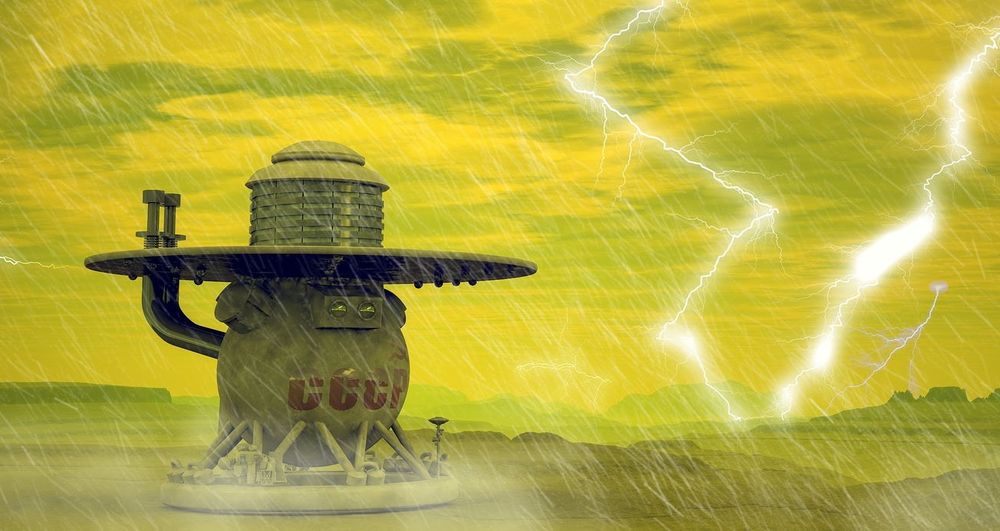By 1961 the space race between the United States and the Soviet Union had been going on for six years. The Soviets had the upper hand, having been the first to launch an artificial satellite into orbit, Sputnik 1, on October 4, 1957.
They were also ahead of the curve, launching the first living creature, the puppy Laika aboard Sputnik 2, into orbit on November 3 of the same year. And as everyone knows, the first human being, Yuri Gagarin aboard Vostok 1, on April 12, 1961.
Just a couple of months earlier, on February 12, they also launched the first probe destined for another planet, the Venera 1. Its objective was to orbit Venus, but the malfunction of a sensor caused it to lose contact with the Earth before approaching within 100,000 kilometers of the planet. It was the first probe to combine all the instruments needed on an interplanetary spacecraft: solar panels, parabolic telemetry antenna, three-axis stabilization, and heading correction engine.
Artist's impression of a Venera probe on the surface of Venus. Photo: Pixabay
The Americans managed to overtake the Soviets in the race to Venus, as the following year Mariner 2 managed to get within 35,000 kilometers (22,000 miles) and send back data on the planet's surface temperature.
The Soviets tried again with Venera 2, but a failure due to overheating caused the mission to fail. In 1966 it was the turn of Venera 3, which crashed on the surface of Venus on March 1 of that year. Nevertheless, it became the first human-made spacecraft to reach another planet.
The following Venera 4, 5 and 6, although they sent back important data on the atmosphere and pressure on Venus that complemented those provided by the U.S. Mariner 3, 4 and 5, also failed to get closer than about 18 kilometers in altitude, where the high pressures destroyed them.
It would take until December 15, 1970, approximately one year and five months after Armstrong and Aldrin stepped on the surface of the Moon, making a giant leap in the space race, for the Soviets to get their small revenge: to be the first to land a spacecraft on the surface of another planet.
They achieved it with the Venera 7, which became the first human-made craft to make a controlled soft descent on the surface of Venus, and also made the first successful data transmission from the surface of another planet to Earth.
It was launched on August 17, 1970 and some four months later entered the atmosphere of Venus. At 05:34:10 that same day, the 495 kilograms of Venera 7 landed on the surface at coordinates 5ºS 351ºE. But not without difficulties.
Replica of the Venera-7 lander at the Sergei Pavlovich Korolyov Museum of Cosmonautics. Photo: Emerezhko/Wikimedia Commons
Replica of the descent vehicle of Venera-7 at the Lavochkin Scientific Production Association, Moscow. Photo: Stanislav Kozlovskiy/Wikimedia Commons
Although the probe had been designed and oversized in order to ensure its survival in the extreme conditions of Venus (it could withstand 180 bar of pressure and 580 degrees Celsius of temperature), the parachute that was to stop it in the last meters failed. It opened, as planned, at an altitude of 60 kilometers, but a few minutes later it began to fail, causing a faster descent than expected. It ended up failing completely and the probe descended at a speed of 16.5 meters per second (59 kilometers per hour) and overturned on landing causing a misalignment in the radio antenna.
As a result, the signal it emitted was very weak, but it was able to be picked up with temperature telemetry before its battery died. The ground recordings, which were not reviewed until a few weeks later, recorded data on temperature and pressure on Venus. For 23 minutes Venera 7 endured transmitting at an ambient temperature of about 475 degrees Celsius.
The first photograph of the Venusian surface by Venera 9.
Later, another 9 probes of the Venera and Vega programs would manage to land on Venus and transmit data on its geology. The latter managed to survive up to 2 hours, providing the first images and direct observations of the planet's surface.
The following year, on December 2, 1971, the Soviets also succeeded in landing the first human-made lander on Mars, Mars 3.
This article was originally published in La Brújula Verde. It has been translated from Spanish and republished with permission.
















Comments
Post a Comment